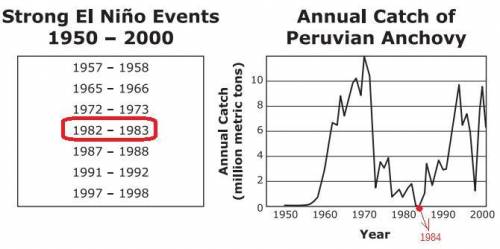
Biology, 12.03.2021 08:40 lpssprinklezlps
What Happened to the Anchovy? - Part 2
Natural events and human activity can threaten the health of the anchovy population off
the coast of Peru. El Niño events are natural events that occur about every two to seven
years. During these events, lower air pressure over South America results in changes to
wind patterns. Normally winds blow from east to west, pushing surface water away from
the coast of Peru. During El Niño events, winds blow from west to east. This pushes
warm surface water toward Peru's coast. The warm surface water contains less oxygen
than cold water and blocks upwelling from bringing nutrients to the surface
Commercial fishing is a human activity that harvests millions of tons of anchovies each
year. In the 1970s, the fishing Industry recognized the need to protect both the
anchovies and the ocean ecosystem. As a result, the government set limits on the
amount of anchovies a fishing boat could catch each year,
The list shows the years in which El Niño events were the strongest. The graph shows
the amount of anchovies caught off the coast of Peru each year,
Strong El Niño Events Annual Catch of
1950 - 2000
Peruvian Anchovy
10
1957 - 1958
1965 - 1966
1972 - 1973
1982 - 1983
1987 - 1988
1991 - 1992
1997 - 1998
Annual Catch
(million metric tons)
1950 1960 1970 1980 1990 2000
Year
Based on the evidence provided, which factors most influenced the
number of anchovies caught in 1984?
A overfishing in previous years and warm waters with few nutrients
B. movement of anchovies to other waters and fishing of large fish
C. conservation of anchovies and habitat management
D. warm winds and low-pressure areas

Answers: 1


Another question on Biology

Biology, 21.06.2019 16:30
Ascientist is studying muscle twitches in chicken quadriceps. to activate the muscle, he needs to provide stimulus to the
Answers: 1


Biology, 22.06.2019 19:30
The recycling of water from the ground via runoff or transpiration through plants back into the atmosphere is known as part of the question 6 options: hydrogen cycle nitrogen cycle transpiration water cycle
Answers: 1

Biology, 22.06.2019 20:00
Transposon can cause mutations in genes at or near the site of transposon insertion. it is possible for these elements to transpose away from their original site, causing a reversion of the mutant phenotype. in some cases, however, even more severe phenotypes appear when these elements excise from this site, due to events at or near the mutant allele. what might be happening to the transposon or the nearby gene to create more severe mutations?
Answers: 2
You know the right answer?
What Happened to the Anchovy? - Part 2
Natural events and human activity can threaten the health of...
Questions

Mathematics, 05.12.2020 02:10


Physics, 05.12.2020 02:10

Biology, 05.12.2020 02:10



Mathematics, 05.12.2020 02:10

History, 05.12.2020 02:10


English, 05.12.2020 02:10


English, 05.12.2020 02:10

Mathematics, 05.12.2020 02:10

Mathematics, 05.12.2020 02:10


Mathematics, 05.12.2020 02:10

Computers and Technology, 05.12.2020 02:10

Spanish, 05.12.2020 02:10

Chemistry, 05.12.2020 02:10





